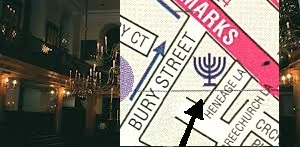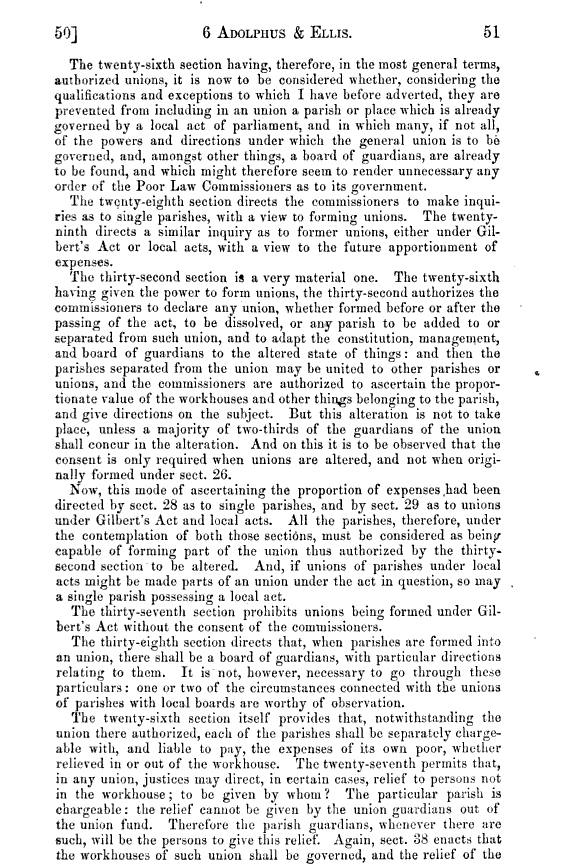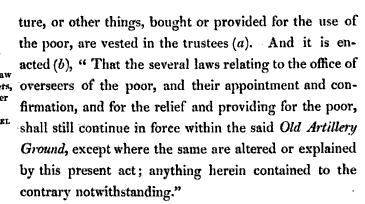A public controversy erupted over Sandy's Row in the 1870's. The synagogue had leased its premises from
the French Church in Soho Square - which had had a succession of denominations as occupants since the French Church vacated in the 1780's. The disused church had been called L'Eglise de l'Artillerie, then later it was known as 'Parliament Court Chapel',as the entrance was on Parliament Court.
It was let to the Chevra in 1867.
The cellars were sublet to a warehouse, which had a separate entrance.
After the lease expired, the landlord approved a renewal, on condition the building was repaired - for a further 21 years.
This would have cost about 700 pounds. The 500 members of Sandy's Row requested public support - which lead to a controversy about the independent congregations - known as Chevrahs - of which Sandy's Row was by far the largest.
Sandy'r Row obtained the funds in the end, and the synagogue was remodelled and the lease was renewed.
At this time, the Ark was moved from the NW corner of the synagogue, to the SE side.
There is an article called "The dedication of Sandy's Row Synagogue' in the Jewish Chronicle, no 85 November 11 1870.
In about 1691 Jacques Laborie, a proselyte and possibly a former Roman Catholic priest, opened a French church in Parliament Court, near Artillery Lane, under the name of l'Eglise de l'Artillerie Lane, apparently with the permission of the Archbishop of Canterbury. (
ref. 117)
The church broke up three or four years later because of Laborie's conduct. The greater part of the congregation moved to Crispin Street, and Laborie started a new church in Pearl Street. (
ref. 117)
Their building in Parliament Court was taken over in 1695 by a congregation which had been formed in about 1691 in or near Petticoat Lane. They now took the name of l'Eglise de l'Artillerie, and re mained in Parliament Court until 1786. (
ref. 118)
The freehold of the site was purchased in 1763 (
ref. 119) and a new church was built. This building, which survives in a much altered form, was opened on 23 November 1766.
One of the ministers of the church was Jacob Bourdillon, who took office on Christmas Day, 1731, and served for over fifty years. (
ref. 120) In 1770 the congregation entered a union with La Patente, Brown's Lane (see page 191), and in 1786 both churches joined the Walloon church in Threadneedle Street. (
ref. 118)
The building in Parliament Court was leased in 1792 to a Universalist Baptist church under Elhanan Winchester of Philadelphia. (
ref. 121) When Winchester returned to the United States a few years later, the church was taken over by William Vidler, who had been associated with Winchester since 1794. When Vidler declared himself to be a Unitarian in 1801, a large part of his congregation seceded. (
ref. 121)
Vidler continued to lead a congregation in Parliament Court until his death in 1816. He was succeeded by William Johnson Fox, who in 1824 took the church to Finsbury where it eventually became an Ethical Society. (
ref. 122)
In 1824 a congregation of Scottish Baptists under S. Stennett and J. Winning came from Cateaton Street. (
ref. 123)
In 1833 the building was called 'Salem Chapel', (
ref. 124) and in 1836 listed as of unspecified denomination. (
ref. 125)
In 1867 the French Church in Soho Square (originally the Threadneedle Street Church) leased the chapel in Artillery Lane to a congregation of Dutch Ashkenazi Jews who had been meeting since 1854 in a house in White's Row, and in Zetland Hall, Mansell Street.
Changes were made to the interior, and a new entrance and vestry provided in Sandy's Row, from the designs of N. S. Joseph. The building was consecrated as a synagogue on 6 November 1870. (
ref. 126)
In 1904 further alterations were made by Lewis Solomon, F.R.I.B.A. (
ref. 127) The freehold was purchased by the congregation in 1923. (
ref. 126)
The plan of the building is a simple rectangle, forty-eight feet in length east to west and thirty six feet wide, with a gallery extending round the north, south and west sides, reached by open stair cases in the north-west and south-west angles.
The stock brick exterior is completely utilitarian and of no interest, but the interior is well designed in a style reminiscent of the Great Synagogue in Fournier Street, also built as a French Protestant church.
Again, the plain plastered walls and the flat ceiling are joined by a quadrant cove springing from a cornice, here with brackets, and there are groined intersections over the arched heads of the windows, four on each side, two at the west end, and three at the east end.
The gallery front, too, is underlined by a triglyphed frieze, supported by widely-spaced Doric plain-shafted columns.
The Ark recess, which is modern, forms an eastern apse with a Baroque frontispiece of Corinthian plain-shafted pilasters supporting an entablature, surmounted by an elaborated pediment.


.png)























































